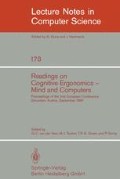Abstract
This is a report on recent research by myself and my colleagues, Max Sime, Stephen Payne and David Gilmore. Where I say "we" and "our" it refers to all of us. I hope I have not misinterpreted their ideas too much.
Previous research at this Unit into the causes of difficulty in comprehending programs led us to the conclusion that it is useful to regard programs in the same light as other forms of presentation of complex information, and to ask how easy is it to extract necessary information from them. This view point emphasises the role of structure: the program structure must be easily perceived, and it must make it easy to perform the user's task given the usual human abilities and disabilities. Structure must be well-specified, visible, and appropriate.
In the first section of this paper I shall briefly outline the course of our work on program comprehension, in order to establish our views on structure. The following sections describe recent research at this Unit into the causes of difficulty in learning and using text editors. We believe that the notations of command languages and of programming languages need to satisfy very similar requirements as regards visible and appropriate structure. The final section offers some conclusions, necessarily tentative.
Preview
Unable to display preview. Download preview PDF.
References
Arblaster, A.T., Sime, M.E. and Green, T.R.G. (1980). Jumping to some purpose. Computer Journal, 22, 105–109.
Bever, T.G. (1970). The cognitive basis for linguistic structures. In Hayes, J. (ed.) Cognition and the Development of Language. New York: Wiley.
Card, S., Moran, T.P. and Newell, A. (1983). The Psychology of Human-Computer Interaction. Erlbaum.
Du Boulay, B., O'Shea, T. and Monk, J. (1981). The black box inside the glass box: Presenting computing concepts to novices. International Journal of Man-Machine Studies, 14, 3, 237–250.
Gilmore, D.J. and Green, T.R.G. (1984). Comprehension and recall of miniature programs. International Journal of Man-Machine Studies, 20, in press.
Green, T.R.G. (1977). Conditional program statements and their comprehensibility to professional programmers. Journal of Occupational Psychology 4, (50), 93–109.
Green, T.R.G. (1980). IFs and THENs: Is nesting just for the birds? Software Practice and Experience, 10, 373–381.
Green, T.R.G. (in press). Global search and replace facilities: A detailed study of four CP/M text editors. Behaviour Information and Technology, in press.
Green, T.R.G. and Payne, S.J. (1982). The woolly jumper: Typographic problems of concurrency in information display. Visible Language, 16, 391–403.
Green, T.R.G. and Payne, S.J. (1983). Organization and learnability in computer languages. International Journal of Man-Machine Studies, 20, in press.
Green, T.R.G., Payne, S.J., Morrison, D.L. and Shaw, A.C. (1982). Friendly interfacing to simple speech recognizers. Behaviour Information and Technology, 2, 23–38.
Green, T.R.G., Payne, S.J., Gilmore, D.J. and Mepham, M. (1984). Predicting expert slips. Proceedings of INTERACT '84, 1st IFIP Conference on Computer Human Factors.
Halstead, M.E. (1977). Elements of Software Science. New York: Elsevier.
Hartley, J. (1978). Designing Instructional Text. London: Kegan Paul.
Ledgard, H., Whiteside, J.A., Navarro, J.A. and Shneiderman, B. (1983). Comprehensibility of programs as a function of identation. Communications of the ACM, 23, 556–563.
Morrison, D.L., Green, T.R.G., Shaw, A.C. and Payne, S.J. (1984). Speech-controlled text-editing: Effects of input modality and of command structure. International Journal of Man-Machine Studies, 20, in press.
Norcio, A.F. (1982). Identation, documentation and programmer comprehension. Proceedings of ACM Conference "Human Factors in Computer Systems", Gaithersburg, Maryland.
Norman, D.A. (1981). Categorization of action slips. Psychological Review, 88, 1–5.
Norman, D.A. (1983). Design rules based on analyses of human error. Communications of the ACM, 26, 254–258.
Payne, S.J. (1984). Task-action grammars. Proceedings of INTERACT '84, 1st IFIP Conference on Computer-Human Factors.
Payne, S.J. and Green, T.R.G. (1983). The user's perception of the interaction language: A two-level model. Proceedings CHI '83 ACM/IEEE Conference on Human Factors in Computer Systems.
Payne, S.J., Sime, M.E. and Green, T.R.G. (1984). Perceptual cueing in a simple command language. International Journal of Man-Machine Studies, 20, in press.
Reason, J. (1979). Actions not as planned: The price of automatization. In G. Underwood (ed.), Aspects of Consciousness, Vol I, London: Academic Press.
Restle, F. (1970). Theory of serial pattern learning: Structural trees. Psychological Review, 77, 481–495.
Sheil, B. (1981). The psychological study of programming. Computer Services, 13, 101–120.
Sheppard, S.B., Krues, E. and Curtis, B. (1981). The effects of symbology and spatial arrangement on the comprehension of software specifications. Proceedings 5th International Conference on Software Engineering, 207–214.
Shneiderman, B. and Mayer, R.E. (1979). Syntactic/Semantic interactions in programmer behaviour: A model and experimental results. International Journal of Computer and Information Sciences, 8, 219–238.
Sime, M.E., Green, T.R.G. and Guest, D.J. (1973). Psychological evaluation of two conditional constructions used in computer languages. International Journal of Man-Machine Studies, 5, 105–113.
Sime, M.E., Green, T.R.G. and Guest, D.J. (1977). Scope marking in computer conditionals: A psychological evaluation. International Journal of Man-Machine Studies, 9, 107–118.
Sloboda, J. (1981). Space in music notation. Visible Notation, 15, 86–110.
Sufrin, B. (1982). Formal specification of a display-oriented text editor. Science fo Computer Programming, 1, 157–202.
Szlichcinski, K.P. (1979). Telling people how things work. Applied Ergonomics, 10, 2–8.
Van der Veer, G.C. and van de Wolde, G.J.E. (1983). Individual differences and aspects of control flow notations. In T.R.G. Green, S.J. Payne and G.C. van der Veer (eds.), The Psychology of Computer Use. London: Academic Press.
Wright, P. (1977). Presenting technical information: A survey of research findings. Instructional Science, 6, 93–134.
Author information
Authors and Affiliations
Editor information
Rights and permissions
Copyright information
© 1984 Springer-Verlag Berlin Heidelberg
About this paper
Cite this paper
Green, T.R.G. (1984). Cognitive ergonomic research at SAPU, Sheffield. In: van der Veer, G.C., Tauber, M.J., Green, T.R.G., Gorny, P. (eds) Readings on Cognitive Ergonomics — Mind and Computers. Lecture Notes in Computer Science, vol 178. Springer, Berlin, Heidelberg. https://doi.org/10.1007/3-540-13394-1_9
Download citation
DOI: https://doi.org/10.1007/3-540-13394-1_9
Published:
Publisher Name: Springer, Berlin, Heidelberg
Print ISBN: 978-3-540-13394-0
Online ISBN: 978-3-540-38944-6
eBook Packages: Springer Book Archive

